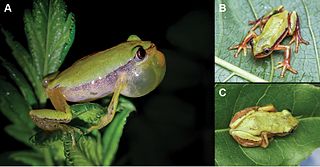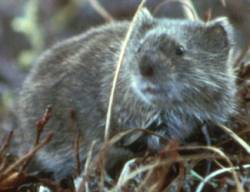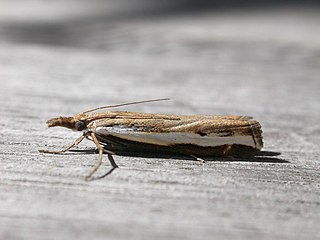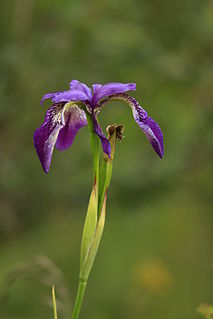Andrachne is a genus of flowering plants in the family Phyllanthaceae described by Linnaeus in 1753. It is one of eight genera in the tribe Poranthereae.

The dibatag, or Clarke's gazelle, is a medium-sized slender antelope native to Ethiopia and Somalia. Though not a true gazelle, it is similarly marked, with long legs and neck. It is often confused with the gerenuk due to their striking resemblance. The typical head-and-body length is about 103 to 117 cm. They stand up to about 80 to 90 cm. Male dibatag weigh between 20 and 35 kg, whereas females range from 22 and 29 kg. The length of the curved horns, present only on males, is typically between 10 and 25 cm. The upper parts are gray to fawn, while the dorsal and lateral areas are cinnamon to rufous. The underparts, rump and the insides of the legs are all white. While markings are visible on the face, there are none on the flanks or the buttocks.
Charles Baron Clarke was a British botanist. He was born at Andover, the eldest son of Turner Poulter Clarke. He was educated at King's College School, London, and at Trinity and Queens' Colleges, Cambridge. He began the study of law at Lincoln's Inn in 1856 and was called to the bar in 1860. He lectured in mathematics at Presidency College, Calcutta, from 1857 to 1865. Clarke was Inspector of Schools in Eastern Bengal and later of India, and superintendent of the Calcutta Botanical Garden from 1869 to 1871. He retired from the Indian Civil Service in 1887. He was president of the Linnean Society from 1894 to 1896, and was elected a fellow of the Royal Society in 1882. He worked at Royal Botanic Gardens Kew until his death in 1906.
Clarke's vole is a species of rodent in the family Cricetidae. It is found only in China.

Afrixalus clarkei is a species of frog in the family Hyperoliidae. It is endemic to southwestern Ethiopia and has been recorded from near Chira, Jimma, Bonga, and Bodare. The specific name clarkei honours Mr and Mrs R. O. S. Clarke, who are acknowledged for their help and hospitality. Common name Clarke's banana frog has been coined for this species.
Ocotea clarkei is a species of Ocotea in the Lauraceae plant family. It is an evergreen tree that is endemic to the Mexican state of Chiapas.

Alexandromys is a subgenus of voles in the genus Microtus. Species in this subgenus are:

Orocrambus is a genus of moths of the Crambidae family. All species are endemic to New Zealand.
Trochocarpa clarkei, commonly known as lilac berry, is a rare flowering plant in the family Ericaceae. It is endemic to sub-alpine areas of Victoria in Australia. It is a shrub which grows to around 30 cm high. The flowers are maroon with a greenish base. The fruits, which appear in autumn, are about 8 mm in diameter. These are eaten by small mammals and birds. The species occurs in subalpine areas of the southern highlands, often in association with Eucalyptus pauciflora.
Fusivoluta clarkei is a species of sea snail, a marine gastropod mollusc in the family Volutidae, the volutes.
Trinorfolkia clarkei, known commonly as the Clarke's triplefin, is a species of triplefin blenny in the genus Trinorfolkia. It was described by Morton in 1888.
Gahnia clarkei is a species of evergreen plant from a sedge family that can be found in Australia. The plant is 1.5–2 metres high, with the same width. They grow during summer and have large black to brownish flowers. The flowers contain seed heads that produce small red seeds.

Orocrambus clarkei is a moth in the Crambidae family. It was described by Alfred Philpott in 1930. This species is endemic to New Zealand. It is known from Mount Moltke, Minaret Peak, Homer Saddle and the Humboldt Range.
Tragocephalini is a tribe of longhorn beetles of the Lamiinae subfamily. It was described by Thomson in 1857.

Iris clarkei is a species in the genus Iris, also the subgenus of Limniris and in the Iris series Sibiricae. It is a rhizomatous herbaceous perennial, from Asia, including north east India, Nepal, Tibet, Bhutan, Burma and in China. It has grey-green leaves, long and thin green stem and violet, to dark blue, to blue or reddish purple flowers.
Spilotragus is a genus of longhorn beetles of the subfamily Lamiinae, containing the following species:
Spilotragus crucifer is a species of beetle in the family Cerambycidae. It was described by Per Olof Christopher Aurivillius in 1908. It is known from Somalia and Kenya.
Spilotragus ornatus is a species of beetle in the family Cerambycidae. It was described by Charles Joseph Gahan in 1898.
Spilotragus variabilis is a species of beetle in the family Cerambycidae. It was described by Jordan in 1897.
Spilotragus xanthus is a species of beetle in the family Cerambycidae. It was described by Jordan in 1903. It is known from Mozambique and the Democratic Republic of the Congo.







